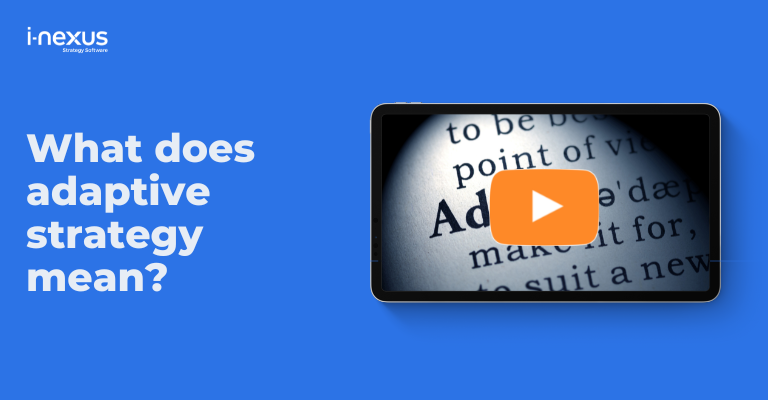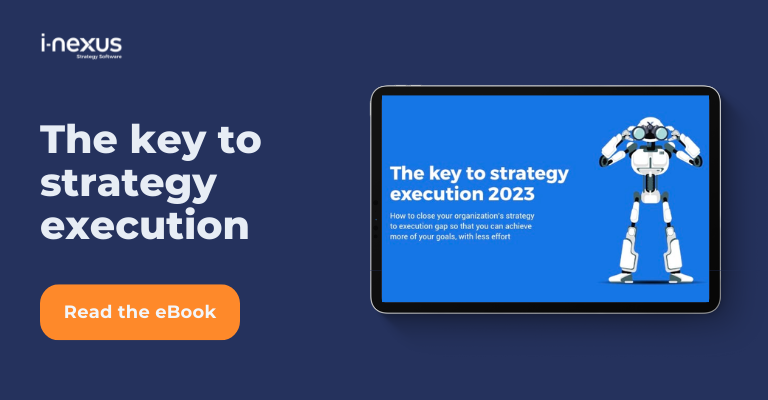Your guide to the A-Z of strategy execution management terminology to bring unison in your understanding and execution of your transformation efforts across your organization.
Written by: James Milsom, Head of Marketing
Over the course of our time working with transformation and strategic leaders we have noticed the array of knowledge and expertise in the Strategy Execution community.
What became apparent in our engagements were the degrees of variation between our understandings of what Strategy Execution Management is and the meanings that can come from one tool or framework.
That is why we collated notes from these sessions, building a map of the differences – consolidating them to present this Strategy Execution Management jargon buster.
In fact, it is the definitive reference for seasoned veterans, aspiring leaders, and everyone in between.
Read on to discover 50+ terms used in the world of strategic management, and keep these to hand to ensure consistency of understanding and drive alignment across your entire organization as you undertake your transformation.
Action Plan
A program or project planning tool that helps you determine if your plan is achievable by listing out the key milestones and the impact each milestone should have on the monthly targets.
Adaptive Strategy
A reflective form of strategic thinking focused on pragmatism. Leaders take responsibility for performance but involve managers with constantly reviewing external and internal conditions, strengths and weaknesses to adapt to their strategy to their environment. It is one of two approaches suggested by Chaffee.
Alignment
Ensuring that your entire business is strategically fine-tuned in all their actions – resource, activity, measurements, communication and teams are aligned to what it is the business must achieve, as defined by the strategy, implementation and execution phases.
Annual Objectives
Annual objectives / goals are what is required this year to meet the three to five- breakthrough objectives / goals.
Balanced Scorecard
A process to translate your strategic plan into metrics focused on different perspectives - finance, customers, process and learning.
Business Model Canvas
Sometimes used alongside an operating model canvas, the business model canvas helps you to understand your existing business model and how it creates, delivers and reviews value for customers.
Through this model you will identify your top customer segments, define your products, services and how your help customers, your core revenue streams, channels used to market to customers, how you maintain customer relations, as well as the daily activities, resources and partners needed to deliver this value, plus the cost.
Breakthrough Performance
Transformation revolves around making a step change in how we conduct ourselves in a business – goal setting, resource, learning, tools etc. Breakthrough performance comes from that significant transformation – it could mean more revenue, reduced operating spend, churn rate, defects per million opportunities etc.
Business Policy
The business policy concerns itself with the purpose, organizational identity, what needs to be achieved, and utilization of resources to support any given strategy, project portfolio or task.
Business System
Rarely will larger organizations take a strategic framework and apply it as it was written. Countless examples exist where businesses take different elements of a strategic framework, combine it with Lean thinking and continuous improvement and produce their own business system. A standout example is Danaher’s Danaher Business System.
Catchball
A participatory technique which sees negotiation and cooperation between divisions, departments and functions to set goals aligned to a strategy. It is commonly linked to Hoshin Kanri.
Change Model
A leadership approach to strategic management whereby you drive change and performance from your team by offering monetary or another form of compensation. It is one of five models suggested by Bourgeois III and Brodwin in this space.
Collaborative Model
A leadership approach to strategic management where leaders actively engage the organization in strategy setting to induce more engagement from team members. It is one of five models suggested by Bourgeois III and Brodwin in this space.
Commander Model
A leadership approach to strategic management whereby the CEO and leadership team creates a strategy and works with line management to implement the strategy. It is one of five models suggested by Bourgeois III and Brodwin in this space.
Continuous Improvement
A management approach which looks at increasing business effectiveness by reducing inefficiencies, frustrations, and waste (time, effort, material, etc.).
Countermeasures
A countermeasure is an action(s) against a process problem in an immediate sense. Countermeasures eliminate the symptoms of underperformance and are the result of problem-solving techniques such as a root cause analysis. When implemented effectively, the countermeasure will allow the rest of the process to continue smoothly.
Cultural Model
A leadership approach to strategic management which builds an appropriate culture for change to succeed. It is one of five models suggested by Bourgeois III and Brodwin in this space.
Crescive Model
A leadership approach to strategic management which adopts a bottom-up mindset. The CEO is the arbiter who receives suggestions on strategy and implementation, and then takes the most appropriate course of direction to support their vision. It is one of five models suggested by Bourgeois III and Brodwin in this space.
Daily Management
Giving daily attention to issues which occur within business as usual.
Discontinuity
A theory from Peter Drucker’s Age of Discontinuity thesis, this is a phenomenon which states technology outstrips experiences, ineffective industries fall for innovative ones to rise, and knowledge is the most valuable asset to your business.
Digital Transformation
A shift in how a business operates – the evolution of digitizing your data, it takes your business information and combines it with new technology to inform your processes, culture, product development and customer service to ensure you can serve your customers’ needs.
Employee Engagement
The means of keeping your staff motivated and satisfied with the work they undertake – often a poor engagement rate is the cause of employee churn.
Failure Factors
Strategic efforts typically fail through five ‘themes’ - ownership, communication, fire fighting, change management and commitment.
Four Disciplines of Execution (4DX)
A strategic framework where action is driven by the concept of lead metrics. What is it that we can do right now, how do we know we are achieving it, and how can we quickly adjust if necessary?
These are referred to as ‘wildly important goals’ which provide focus for your business to action on and make use of balanced scorecards to track progress and review the need for corrective action
Gantt Chart
A bar chart project management tool to understand the schedule of a project, identifying where resources will be employed and milestones for producing benefits.
Gap Analysis
Similar to continuous improvement’s value stream mapping technique, this is a process where you take your strategic vision, analyze your internal and external situation and then map out what the future, ideal situation is. The gap between the two is where you will discover the actions needed to achieve this change.
Hoshin Kanri
Sometimes known as Hoshin Planning, Policy, Goal or Strategy Deployment – is a strategic planning process whereby strategic goals are communicated and translated into action.
IFE Matrix
IFE (Internal Factor Evaluation) is a strategic tool to determine the internal strengths and weaknesses of your organization, using weightings for different factors and creating a score, with the ideal being the balancing of each.
When combined with VRIO you can ascertain how to mobilize internal resource vs. your competitors and external environment, as well as shape your resource planning and hiring strategy.
Kaizen
A Japanese philosophy which sees improvement in productivity and customer experience as a gradual and methodical process. Kaizen is a mindset and will involve tools such as the kanban, kaizen event and a kamishibai board to make your culture one where improvements are sought and acted upon each day.
Linear Strategy
A prescriptive form of strategic thinking focusing on sequences. Goals lead to actions and actions lead to results. Results are measured and these feed new goals. It is one of two approaches suggested by Chaffee.
Machine Assisted Learning
The use of computing to learn how to complete a task without being explicitly programmed. In strategy this is likely to emerge as simulating strategic plans to help your business to identify the most appropriate route forward.
Management by Objectives (MBO)
A strategic framework where supervisors and supervisees agree together what their goals and aspirations should be, how those align with the company’s vision, and how the accomplishment of these will be assessed, using the now standard SMART goal definition process.
McKinsey 7S
A strategic tool that analyzes your business’ design from seven perspectives: strategy, structure, systems, shared values, style, staff and skills. It is an effective tool to help in identifying how prepared you are to achieve your goals.
The key takeaway is that your business must have all seven areas aligned to allow your transformation efforts to be successful.
OGSM
Objective, goals, strategies and measures – a system that helps you to define your goals based on those which are broad, fixed and measurable, ensuring your actions and their measures link back to your strategy.
OKR
Objectives and Key Results is a model that looks at outcomes, linked to your strategy, which examines outcomes on a fluid basis each quarter.
OKRs are attached to action plans to ensure your key objectives and their results are measured and achievable.
Operational Management
The management of daily work within an organization, ensuring that production and other teams maintain their expected work. Process optimization from continuous improvement will feed into business-as-usual activity (standardized work) through operational management.
Pareto Analysis
A statistical technique which helps you to identify what problems / actions have the greatest impact, aiding data-driven decision making.
It originates from the Pareto Principle that 80% of value is found in 20% of work. It will typically be used in your goal setting or when performing a root cause analysis.
Performance Management
This is a disciplined approach to establishing, tracking and acting on data from daily work and using it as a tool to guide our efforts.
When performed regularly and in an educational manner, performance management empowers organizations and their individuals to progress in their work and build knowledge, skills and critical thinking to become better professionals.
PESTEL
A strategic planning tool to identify the external (macro) pressures on your organization. It looks towards political, economic, social, technological, environmental (or ethical) and legal issues that will shape how your strategy results.
By being wary of the external factors you can ensure that a strategy is built with a conscious understanding of the elements which can diminish its impact.
Plan-Do-Check-Act:
The infamous Deming cycle which influences many strategic frameworks:
- Plan: Define your goals and map out how you’ll achieve them
- Do: Implement your plan
- Check: Assess the results of your plan and understand any improvements that can be made
- Act: Adjust based on your findings from ‘Check’
Porter's 5 Forces
A strategic planning tool to identify the competitive nature of your market and to analyze your strategy’s likelihood of success. It looks at competitive rivalry, the power of your supply chain, the influence of your customers, the threat of being substituted and the likelihood of new competitors entering the market or the market changing altogether.
Porter's Value Chain
An extension of the Voice of the Customer, this is a technique to understand how value is being created in your business.
The value chain analysis encourages a business to assess how it delivers value by looking at its primary activities (inbound logistics, your operations, delivery of product, marketing and sales, and service) and support activities (purchasing, people management, technological development and your infrastructure).
The result should be an action plan of opportunities where value can be improved (cost savings, new supplies, new process etc.)
Portfolio Management
The groupings of projects tied to initiatives that feed your annual and breakthrough objectives is portfolio management.
The art is to coordinate different portfolios, analyzing their results and investment and, ultimately, balance the mix to deliver on your targets and doing so with the resource available.
Strategic Framework
A strategic framework is a structured method to support an organization to achieve its strategy, covering planning, implementation and execution. Examples include:
Strategic Implementation Matrix
A strategic implementation matrix is a written plan which asks:
1. Policy - What are we implementing?
2. Actions - What actions are required?
3. Owner - Who owns these actions?
4. System - What systems do we need?
5. Budget - What is the cost?
6. Pot - Which budget pot pays for the cost?
7. Time - When must we finish by?
8. Status - What is the current status?
Strategy Canvas
A diagnostic tool which illustrates your existing strategic environment and the potential future state of the organization should be the strategy be executed correctly.
A product of Kim and Mauborgne, it allows you to see the factors that impact your market, what buyers receive and, in turn, enable you to visualize how to become an alternative provider for your buyers.
Strategy Execution Management
The process of managing a strategy from its formulation through to execution, involving strategic planning, strategic implementation and strategy execution.
Strategy Execution
The operational activity of the strategy – the projects, activity, measurement, performance management, and countermeasures needed to make effective use of resource to reach the objectives of the strategy and realize the benefits of it.
Strategy Formulation
Developing a vision and set of objectives and initiatives which, based on the voice of the customer theory, will deliver a true step change in performance for the organization which aligns to the business’ policy.
Strategy Implementation
The translation of the strategy into breakthrough goals and improvement priorities, the required resources, metrics and defined activities to support the achievement of the strategy.
SWOT
Strengths, Weaknesses, Opportunities and Threats enables you to look at the internal and external factors, chances for success and threats of failure, giving a general direction for what your strategy should be.
Targets To Improve
Similar to a Bowling / Bowler Chart, this is a visual summary of performance in key strategic metrics based on expected vs. actual performance, which can be used on a monthly or weekly basis.
Transformation
The approach of setting out a true step change in your existing performance – be that revenue, product offering etc, where you must make drastically different processes and management systems to achieve a performance level that transforms your business.
Vision Statement
A long-term vision for the company’s future – this is based on goals, long-term, and flows from your mission, it is the where you want the business to be and what that will look like. It is also known as True North in Hoshin Kanri.
Voice of the Customer
The means of gauging and recording a customer’s experiences, expectations and wants from your business and then feeding this into your strategy and resulting Strategy Execution Management.
VRIO
Valuable, rare, inimitable and organized, this acronym helps you to discover the internal resource which will give your business a sustainable competitive advantage.
It asks whether you give value to customers, do you have knowledge / product which is hard to get, is it easy to imitate your knowledge / product and can your organization capitalize on this resource.
X-Matrix
A strategic planning tool that allows you to decompose your Vision into the Breakthrough Objectives, Annual Objectives, Improvement Priorities, Targets and Accountable Owners.
Continue learning about strategy execution
Click here to visit our strategy execution knowledge hub, filled with content to support you in embracing the 'no normal' of strategy in the 2020s and beyond, or explore these recommendations:
- Why critical thinking is crucial for strategy execution: Discover the five-step critical thinking process to laying out a high-quality, focused, measurable, and realistic annual strategic plan.
- How AI and machine-assisted learning will help your strategy execution: As Artificial Intelligence becomes a mainstay in our lives, read how AI and machine-assisted learning will evolve to support your Strategy Execution.
- Download our key to strategy execution eBook: Read how companies like Danaher and HP have mastered strategy execution and what you can learn from them.
About the author
James Milsom is Head of Marketing at i-nexus. James has wide-ranging experience in markets such as telecommunications, energy, education, and software.
As Head of Marketing, his drive is to raise awareness and understanding of the challenges facing enterprises in delivering strategic objectives and transformation amidst changing markets and the obstacles traditional tools and methods present leaders.
If you’d like to talk more about Strategy Execution, reach out to James on james.milsom@i-nexus.com or connect with him on LinkedIn for the latest insights.






